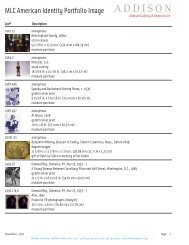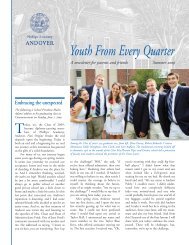The Popularized “Housewife” in Advertisements by Michael Naughton
The Popularized “Housewife” in Advertisements by Michael Naughton
The Popularized “Housewife” in Advertisements by Michael Naughton
Create successful ePaper yourself
Turn your PDF publications into a flip-book with our unique Google optimized e-Paper software.
<strong>The</strong> <strong>Popularized</strong> <strong>“Housewife”</strong> <strong>in</strong> <strong>Advertisements</strong><br />
<strong>by</strong><br />
<strong>Michael</strong> <strong>Naughton</strong>
In the periods before, dur<strong>in</strong>g, and after World War II, popular magaz<strong>in</strong>e<br />
advertisements provided a glimpse <strong>in</strong>to the outside world for readers. While see<strong>in</strong>g what<br />
items the advertisers wanted them to purchase, women also saw <strong>in</strong> the advertisements<br />
how other women acted and lived <strong>in</strong> an idealized world. Obviously, the scenes depicted<br />
<strong>in</strong> these ads were not representative of real life, yet many women forgivably believed that<br />
they, too, should live <strong>in</strong> the ways the ads portrayed women to live. <strong>The</strong> advertisements of<br />
household products <strong>in</strong> the immediate post-WWII period established the image of the<br />
housewife, represent<strong>in</strong>g women whose collective job was entirely a domestic one. <strong>The</strong><br />
advertisers did this <strong>by</strong> first creat<strong>in</strong>g the housewife as women’s expected full-time job,<br />
then mak<strong>in</strong>g the job look sexy and appeal<strong>in</strong>g, and f<strong>in</strong>ally allow<strong>in</strong>g women to see<br />
themselves <strong>in</strong> those same roles.<br />
While the United States was supply<strong>in</strong>g mostly male troops to fight <strong>in</strong> WWII, the<br />
government used propaganda to get women <strong>in</strong>to the jobs men had left beh<strong>in</strong>d. This<br />
propaganda also spilled <strong>in</strong>to advertisements portray<strong>in</strong>g “Rosie the Riveter,” a woman<br />
work<strong>in</strong>g <strong>in</strong> the factory jobs to support the war effort. As soon as the war ended, however,<br />
and men came home search<strong>in</strong>g for work, a new set of propaganda arose, this time urg<strong>in</strong>g<br />
women to go back to the home. While the image of the homemaker began replac<strong>in</strong>g<br />
Rosie the Riveter as the national female model <strong>in</strong> advertisements, a new, post-war culture<br />
was grow<strong>in</strong>g. <strong>The</strong> culture became <strong>in</strong>creas<strong>in</strong>gly domestic, as the return to a boom<strong>in</strong>g<br />
peacetime economy created a huge market for consumer goods. 1 <strong>The</strong> home, family, and<br />
children were at the center of this culture, and advertisements portrayed these trends. 2<br />
1<br />
Lois W. Banner, Women <strong>in</strong> Modern America, A Brief History (New York, Harcourt Brace Jovanovich,<br />
1974), 215.<br />
2<br />
Carolyn Hitch, <strong>The</strong> Girl on the Magaz<strong>in</strong>e Cover (Chapel Hill, University of North Carol<strong>in</strong>a Press, 2001),<br />
148
<strong>The</strong> woman, as the spender of this new household unit, understandably became the target<br />
of many consumer products.<br />
<strong>Advertisements</strong>, <strong>by</strong> their very nature, did not serve only to sell an item. <strong>The</strong>y,<br />
along with other articles or radio broadcasts of the time, showed the public how other<br />
people <strong>in</strong> the world acted. In essence, a successful advertisement strove to turn the<br />
consumer <strong>in</strong>to the eager buyer portrayed <strong>in</strong> the ads. 3 <strong>The</strong>refore, whether <strong>in</strong>tentionally or<br />
not, the creators of household product ads made it appear that the full time job of a<br />
woman should be a housewife. As opposed to what many people believed, these images<br />
of women <strong>in</strong> the home did not accurately represent women of the time; after the war,<br />
women were still enter<strong>in</strong>g the workforce at a very high rate. 4<br />
<strong>The</strong> advertisements communicated that this ‘housewife’ role was the normal, full-<br />
time job of all women through many techniques. One way they did this was <strong>by</strong><br />
exhibit<strong>in</strong>g all the numerous tasks expected of housewives. In an ad for NIL, a spray<br />
meant to “NIL odors” around the house, there is a collection of seven areas of the house,<br />
with a cartoonish-look<strong>in</strong>g housewife spray<strong>in</strong>g the NIL product <strong>in</strong> each. <strong>The</strong>se seven<br />
areas represent a huge amount of work for this housewife. <strong>The</strong> caption under one of<br />
these scenes even reads, “A clean, odorless toilet bowl is a sign of a fastidious<br />
housewife.” 5 <strong>The</strong> huge task of keep<strong>in</strong>g the entire house tidy discourages women from<br />
perform<strong>in</strong>g any other work. This ad also represents every one of the tasks a housewife is<br />
supposed to accomplish, creat<strong>in</strong>g a virtual “job description” right here <strong>in</strong> the<br />
advertisement. <strong>The</strong> ad po<strong>in</strong>ts out that NIL can kill odors <strong>in</strong> the nursery, kitchen, and<br />
3 Glenna Matthews, “Just a Housewife”: the Rise and Fall of Domesticity <strong>in</strong> America (New York, Oxford<br />
University Press, 1987), 148.<br />
4 Banner, 252<br />
5 Life, “NIL ad,” Jun 16 1947, 121
liv<strong>in</strong>g room, <strong>in</strong>s<strong>in</strong>uat<strong>in</strong>g that it is the housewife’s job to ma<strong>in</strong>ta<strong>in</strong> cleanl<strong>in</strong>ess <strong>in</strong> all these<br />
areas.<br />
Not only did these advertisements portray the many tasks <strong>in</strong> a housewife’s job,<br />
but many also made housewives feel they had to compete with one another. In an ad for<br />
a General Electric dishwasher, the text reads, “Even sticky pots come out sparkl<strong>in</strong>g<br />
clean!” and “Your kitchen’s cleaner all day because G-E holds (and hides) dirty dishes<br />
and utensils as you use them.” 6 From whom would these women have felt they needed<br />
to hide their ‘dirty dishes?’ Obviously, these women would have been hid<strong>in</strong>g their dishes<br />
not from their husbands, or children, but <strong>in</strong>stead from their neighbors. This ad<br />
emphasizes an idea that these women must be compet<strong>in</strong>g to have better function<strong>in</strong>g<br />
homes than their neighbors, the other housewives. Moreover, <strong>in</strong> an ad for Hotpo<strong>in</strong>t<br />
Appliances, the advertisers showed this competition was worldwide for housewives. It<br />
reads, “All (appliances) are custom-matched to make your kitchen and home laundry one<br />
of the most beautiful and most efficient <strong>in</strong> America.” 7 <strong>The</strong>se advertisements made it<br />
appear that hav<strong>in</strong>g the best-run house was <strong>in</strong>credibly important, but to compete, women<br />
would have needed to devote all of their time clean<strong>in</strong>g and work<strong>in</strong>g as housewives.<br />
<strong>The</strong>se ads also showed that women, as full-time housewives, were expected to be<br />
full-time servants for their husbands. An ad for Schlitz Beer summarizes this expectation<br />
fully, as the image shows a woman cook<strong>in</strong>g food for her husband. She has burned the<br />
food and is quite upset that she has ru<strong>in</strong>ed her husband’s d<strong>in</strong>ner. Obviously, it is not<br />
acceptable that she has burned the food, s<strong>in</strong>ce the text later reads, “<strong>The</strong>re’s hope for any<br />
6 Life, “General Electric Ad,” Feb 11 1952, 7<br />
7 Life, “Hotpo<strong>in</strong>t Appliances Ad,” Feb 11 1952, 60-61
young bride who knows her man well enough to serve him Schlitz beer.” 8 Even though<br />
this is a beer ad, the image of women serv<strong>in</strong>g men was so well known that the advertisers<br />
needed not show beer <strong>in</strong> the scene; <strong>in</strong>stead, they showed a woman <strong>in</strong> her understood role,<br />
serv<strong>in</strong>g her “man of the house.” <strong>The</strong> theme of ‘time sav<strong>in</strong>g,’ closely related to serv<strong>in</strong>g, is<br />
also present <strong>in</strong> many ads of the time. <strong>The</strong> title of a Norge Appliance ad reads, “Th<strong>in</strong>k<br />
first of yourself,” and the text reads, “You women – always th<strong>in</strong>k<strong>in</strong>g of others. But when<br />
it comes to. . . Norge Appliances, you will f<strong>in</strong>d the answer to your dreams <strong>in</strong> lightened<br />
domestic duties.” 9 <strong>The</strong> expectation, as the ad first implies, was not that the women would<br />
use this time for themselves; <strong>in</strong>stead, time would free up so that they could serve their<br />
husbands even more. Also, <strong>in</strong> a pre-r<strong>in</strong>s<strong>in</strong>g dishwasher ad, the expectation visually<br />
presents itself once aga<strong>in</strong>: while the man lounges comfortably <strong>in</strong> the liv<strong>in</strong>g room, the<br />
housewife, almost out of sight, is r<strong>in</strong>s<strong>in</strong>g dishes after supper. With images like these<br />
flood<strong>in</strong>g magaz<strong>in</strong>es, it becomes clear how quickly women understood their serv<strong>in</strong>g role<br />
<strong>in</strong> marriage, and part of their job description was to always make their husbands happy.<br />
In addition, the ads <strong>in</strong> the post-war era showed that women, <strong>in</strong> their housewife<br />
role, had immense responsibilities toward their children. <strong>Advertisements</strong> often warned<br />
women directly about their great responsibility as buyers, for purchas<strong>in</strong>g the wrong<br />
products would br<strong>in</strong>g harm to their children, who are at the center of the new ba<strong>by</strong>-boom<br />
culture. 10 Only women who were <strong>in</strong>formed of these dangers, as it were, could be the best<br />
housewives and mothers, and images stressed this fact. 11 For example, <strong>in</strong> a Miss Curity<br />
Bandage ad, an <strong>in</strong>formation box on the ad itself expla<strong>in</strong>s what mothers should do <strong>in</strong> case<br />
8 Life, “Schlitz Beer Ad,” Feb 4 1952, 90<br />
9 Life, “Norge Appliance Ad,” Jun 16 1947, 69<br />
10 Hitch, 172
of burns. This creates great responsibility for women, mak<strong>in</strong>g them believe that they<br />
must always have been on call <strong>in</strong> case someth<strong>in</strong>g happened to their ‘helpless’ children.<br />
This ad also shows how important this housewife job really was, as the text reads, “Use<br />
the same first-aid dress<strong>in</strong>gs most lead<strong>in</strong>g hospitals do – Curity.” 12 Curity blatantly<br />
argued that this housewife job was as important as that of an emergency room worker.<br />
Any woman follow<strong>in</strong>g these guidel<strong>in</strong>es, then, had this immensely important housewife<br />
task as her number one priority.<br />
F<strong>in</strong>ally, the ads show that the housewife, like any man with an occupation, had a<br />
certa<strong>in</strong> uniform and office. <strong>The</strong> ads showed women do<strong>in</strong>g housework and wear<strong>in</strong>g<br />
aprons, skirts, high heels, and pearls. Men realized the importance of this uniform and<br />
what it represented; one newspaper op<strong>in</strong>ion read, “It is only s<strong>in</strong>ce some of the girls began<br />
to climb out of the Hoover aprons and <strong>in</strong>to the Chanel and Dior suits . . . that the boys<br />
have gone <strong>in</strong> for headshak<strong>in</strong>gs and mutter<strong>in</strong>gs . . . about woman’s place be<strong>in</strong>g <strong>in</strong> the<br />
home.” 13 <strong>The</strong> ads also showed that women were expected to be <strong>in</strong> this ‘professional<br />
uniform’ at all times. In a Postum coffee ad, while the man has just woken up and is <strong>in</strong><br />
his pajamas, the woman is already <strong>in</strong> a professional-look<strong>in</strong>g nightgown that looks like<br />
housewife-wear. 14 Even <strong>in</strong> terms of dress, society expected women to be presentable<br />
housewives at all times. Moreover, the fact that ads almost always represented women <strong>in</strong><br />
the kitchen, as <strong>in</strong> the GE pre-r<strong>in</strong>s<strong>in</strong>g dishwasher ad, <strong>in</strong>dicates the kitchen was their office.<br />
<strong>The</strong> architecture of the kitchen, as a white box separated from the public, set up a work<br />
11<br />
Daniel Delis Hill, Advertis<strong>in</strong>g to the American Woman 1900-1999 (Columbus, Ohio State University<br />
Press, 2002) 79<br />
12<br />
Life “Curity Ad,” Feb 4 1952, 102<br />
13<br />
“Woman <strong>in</strong> the Gay Flannel Suit,” Bernice Fitz-Gibbon, New York Times, 29 Jan 1956, 196.<br />
14 Life “Potsum Ad,” Sept 4 1950, 91
area analogous to offices of white-collar middle-class men. 15 In a Hotpo<strong>in</strong>t Appliance ad,<br />
for <strong>in</strong>stance, the kitchen is clean, white, sh<strong>in</strong>y, and very pleasant-look<strong>in</strong>g. <strong>The</strong> kitchen –<br />
the work area – completely surrounds the housewife with appliances, flowers, and white<br />
cab<strong>in</strong>ets, <strong>in</strong>dicat<strong>in</strong>g that women should spend their time here to make it look so pleasant<br />
and clean. <strong>The</strong> establishment of job elements, like uniforms and offices, solidified that<br />
the housewife was, <strong>in</strong>deed, as important a job as any other was.<br />
Once this job had been established, the ads next strove to conv<strong>in</strong>ce women that it<br />
was also the job for them. Advertisers needed to make this task look appeal<strong>in</strong>g and sexy<br />
so they could sell their domestic products. For <strong>in</strong>stance, Bernice Fitz-Gibbon, a woman<br />
head<strong>in</strong>g an advertis<strong>in</strong>g agency, argued,<br />
“I was dismayed to learn . . .the average woman feels there is someth<strong>in</strong>g<br />
demean<strong>in</strong>g about car<strong>in</strong>g for a home and that she feels defeated when she has to<br />
write down her occupation as housewife. That’s fem<strong>in</strong>ist propaganda . . don’t you<br />
believe one word of it.” 16<br />
It was apparent that advertisers like Fitz-Gibbon wanted women to accept their<br />
positions as housewives, so ads also made women who performed these tasks appear<br />
attractive and happy. Sara Evans, the author of Born for Liberty, proposes that sexuality<br />
arose <strong>in</strong> advertisements only when the woman portrayed was married; the ads made it<br />
sexy to be married or a mother. 17 For <strong>in</strong>stance, <strong>in</strong> a Scot tissue ad, the housewife is<br />
<strong>in</strong>timately car<strong>in</strong>g for her child. She is very beautiful, smil<strong>in</strong>g, and undoubtedly shown <strong>in</strong><br />
an appeal<strong>in</strong>g manner. 18 Women, of course, would like to appear sexy and desirable for<br />
their husbands, and ads show them that one surefire way to become sexy would be to<br />
become housewives. <strong>The</strong>y also would have wanted to know their work would be<br />
15 Evans, 249<br />
16 Fitz-Gibbon, New York Times<br />
17 Evans, 248
eward<strong>in</strong>g; <strong>in</strong> the Hotpo<strong>in</strong>t appliance ad, the woman is practically jump<strong>in</strong>g with<br />
excitement to see her dishes are clean. 19 It must have been hard for woman to reject a job<br />
that <strong>in</strong>tentionally appeared so appeal<strong>in</strong>g and fun.<br />
<strong>The</strong> f<strong>in</strong>al tactic advertisers utilized to conv<strong>in</strong>ce women to take up housework as<br />
their occupation was craftily mak<strong>in</strong>g the reader see herself <strong>in</strong> that role. First, to do this,<br />
advertisers illustrated universal and slightly vague scenes. Today, there are a few<br />
illustrated ads, for we use celebrities or shots of real people to sell products. Illustration<br />
was the standard <strong>in</strong> the 50’s, however, and it was quite effective at manipulat<strong>in</strong>g<br />
woman’s perceptions. For example, the housewife clean<strong>in</strong>g dishes <strong>in</strong> the Hotpo<strong>in</strong>t<br />
appliance ad is illustrated, and her head is turn<strong>in</strong>g away from us. Any woman, with some<br />
imag<strong>in</strong>ation, could wishfully project herself <strong>in</strong> the illustrated housewife’s position. 20 In<br />
the Ms. Curity ad, on the other hand, the artists decided not even to draw the housewife’s<br />
face, as we can only see her help<strong>in</strong>g hand offer<strong>in</strong>g a bandage to a cry<strong>in</strong>g child. 21 This<br />
lack of specificity not only serves to allow women to see themselves as these housewives,<br />
but it also creates a sense of universality, or that every woman <strong>in</strong> the world is do<strong>in</strong>g the<br />
same as these illustrated women are. And aga<strong>in</strong>, as all the images <strong>in</strong> magaz<strong>in</strong>es served as<br />
views to the outside world for readers, a woman <strong>in</strong> the Cold War era would not have<br />
wished to appear different from these women she saw. <strong>The</strong>se ads, however, did not<br />
represent the reality for women <strong>by</strong> any means, as many <strong>in</strong>deed had jobs outside the home.<br />
However, the last<strong>in</strong>g housewife image was what rema<strong>in</strong>ed impr<strong>in</strong>ted <strong>in</strong> the m<strong>in</strong>ds of all,<br />
conv<strong>in</strong>c<strong>in</strong>g society that the home was and had always been the correct place for women.<br />
18 Life, “Scot Tissue Ad,” Feb 4 1952, 97<br />
19 Life, “Hotpo<strong>in</strong>t Appliance Ad,” Feb. 11 1952, 60-61<br />
20 Life, “Hotpo<strong>in</strong>t Appliance Ad,” Feb 11 1952, 60-61<br />
21 Life “Curity Ad,” Feb 4 1952, 102
<strong>Advertisements</strong> of household products after W.W.II created the image of the<br />
housewife as the expected job for women. <strong>The</strong>y did this <strong>by</strong> outl<strong>in</strong><strong>in</strong>g the various tasks a<br />
housewife would have to deal with, portray<strong>in</strong>g competition with other housewives,<br />
show<strong>in</strong>g how women should serve their husbands and children, and demonstrat<strong>in</strong>g that<br />
housewives, like many other occupations, also have uniforms and offices. In addition,<br />
after the ads established this as a woman’s expected job, they made it appear irresistible<br />
through sex appeal and universality <strong>in</strong> the ads. One can argue that the tasks of<br />
housewives were necessary for the function<strong>in</strong>g of the family unit. Still, these tasks were<br />
often gruel<strong>in</strong>g and they restricted women’s creativity to the conf<strong>in</strong>es of the house.<br />
<strong>Advertisements</strong>, <strong>in</strong> try<strong>in</strong>g to sell their products, created the idea that women should be<br />
locked <strong>in</strong> these domestic prisons throughout the 50’s; it would take a revolution to release<br />
them, both physically and mentally.
Life, “Curity Ad,” Feb 4 1952: 102<br />
Life, “General Electric Ad,” Feb 11 1952: 7<br />
Works Cited<br />
Life, “Hotpo<strong>in</strong>t Appliances Ad,” Feb 11 1952: 60-61<br />
Life, “Housewife.” Jan 16 1947: 105-107<br />
Life, “NIL Ad,” Jun 16 1947: 121<br />
Life, “Norge Appliances Ad,” Jun 16 1947: 69<br />
Life, “Potsum Coffee Ad,” Sept 4 1950: 91<br />
Life, “Schlitz Ad,” Feb. 4 1952: 90<br />
Life, “Scot Tissue Ad,” Feb 4 1952: 97<br />
Banner, Lois W. Women <strong>in</strong> Modern America: A Brief History. New York: Harcourt Brace<br />
Jovanovich, Inc, 1974.<br />
Evans, Sara M. Born For Liberty: A History of Women <strong>in</strong> America. New York: <strong>The</strong> Free<br />
Press. 1989.<br />
Fitz-Gibbon, Bernice. “Woman <strong>in</strong> the Gay Flannel Suit.” New York Times Jan 29 1956,<br />
196.<br />
Hill, Daniel D. Advertis<strong>in</strong>g to the American Woman 1900-1999. Columbus: Ohio State<br />
University Press, 2002.<br />
Hitch, Carolyn. <strong>The</strong> Girl on the Magaz<strong>in</strong>e Cover. Chapel Hill: University of North<br />
Carol<strong>in</strong>a Press, 2001.<br />
Matthews, Glenna. "Just a Housewife": <strong>The</strong> Rise and Fall of Domesticity <strong>in</strong> America.<br />
New York: Oxford University Press, 1987.<br />
Nickerson, Jane. “Food.” New York Times, Jan 1 1950, 37.












